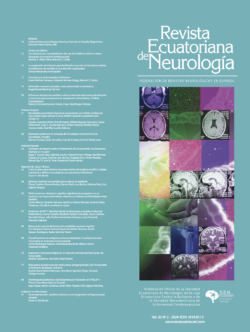Using neuropsychological tests that have normative data from the population in which they are being applied has positive effects on the accuracy and validity of the diagnoses, which can influence the effectiveness of the interventions derived from them. In addition, it provides greater precision in the studies that use such tests. In Ecuador, there are no studies on the use of standardized tests, which is why the objective of this study was to identify the neuropsychological tests for children and adolescents that have been adapted, standardized and/or validated in Ecuador. A systematic review was conducted using the PRISMA model. There are 10 tests with normative data for the Ecuadorian population: Wisconsin Card Sorting Test Modified Version, Trail Making Test, Color and Word Test: STROOP, Peabody Picture Vocabulary Test, Symbol and Digit Test SDMT, Rey Complex Figure – Osterrieth, Learning and Verbal Memory Test (TAMV-I), Concentration Endurance Test (d2), Verbal Fluency Test and Token Test. The instruments allow the evaluation of 17 cognitive functions. Based on the results, it is recommended that the country’s professionals choose to use these tests and their Ecuadorian scales.
psicometría
Escala de Conocimiento de la Enfermedad de Alzheimer: Adaptación y Análisis de las Propiedades Psicométricas en Estudiantes Universitarios Ecuatorianos. Alzheimer’s Disease Knowledge Scale: Adaptation and Analysis of Psychometric Properties in Ecuadorian University Students
The aim of this study was to develop a linguistic adaptation of the Alzheimer’s Disease Knowledge Scale (ADKS), and to provide evidence on the reliability and validity of the adapted test. The ADKS is a self-administered instrument that examines knowledge about risk factors, assessment and diagnosis, symptoms, course, impact on life, care and treatment and management of Alzheimer’s disease (AD).
Methods: An instrumental study was implemented. The ADKS items were adapted to the Ecuadorian use of the Spanish language through an iterative process of translation by experts. Next, a sample of 523 university students completed the adapted scale together with a set of other instruments to analyze the fiability and criterion validity of the scale.
Results: ADKS Ecuador showed good internal consistency (Cronbach’s α=.78), adequate test-retest reliability, p > .05, and convergent and discriminatory evidence of validity when related to other variables.
Conclusion: ADKS Ecuador is an adequate instrument to assess general knowledge about AD in young highlgy educated Ecuadorian population with low dom ain knowledge.
Leer artículo completo
Propiedades psicométricas del test de evaluación neuropsicológica – Neuropsi en población peruana. Psychometric properties of the neuropsychological evaluation test – Neuropsi in peruvian population
This research aims to estimate the psychometric properties of the neuropsychological assessment instrument – Neuropsi in patients treated in the Neurology area of a public hospital in Peru. The study is of a technological, psychometric type, of a non-experimental and cross-sectional design and is oriented through a quantitative approach. We worked with a non-probabilistic sample of 432 medical records of elderly patients who were diagnosed with or without cognitive disorders or dementia, to whom the brief neuropsychological assessment instrument in Spanish – Neuropsi was applied. A factor analysis was found that reports a good fit in a 6-factor model with X2 = 2.825, CFI = 0.990, GFI = 0.986, PNFI = 0.460, AIC = 47.774, SRMR = 0.0196, RMSEA = 0.065 and the Cognitive performance differs according to the age range of the patient. In addition, it has a Cronbach’s alpha reliability of .863. These findings suggest that the instrument is valid, short, accurate, and adequate for measuring cognitive performance.
Leer artículo completo
Test de Lectura de la Mente a través de la Mirada: Primera aproximación a las propiedades psicométricas en población peruana. Reading the Mind in the Eyes Test: A first approximation to the psychometric properties in the Peruvian Population
Theory of mind (ToM) is a central cognitive process of social cognition, with great importance in neuroscience and neuropsychiatric disorders. One method used to evaluate advanced ToM in adults is the Reading the Mind in the Eyes Test (RMET), which despite being widely known in Peru, still lacks standardized and adequately validated measures for its application in the clinical area and not clinical. Objectives: 1. Explore the psychometric properties of RMET in Peruvians, as well as the percentage of precision for each item among the different versions of the RMET; 2. Evaluate the test-retest reliability after one year of follow-up. Two hundred eighty-eight participants between 17 and 55 years old, of both sexes, were recruited. Results: The RMET shows a medium validity and consistency according to the KR-20, Cronbach’s Alpha, and Omega tests (0.645 – 0.666). Women perform better than men (p <0.041*), and scores remain stable after one year of follow-up. Conclusions: The RMET shows good psychometric properties, similar to other versions and different countries, with women showing better mental capacity.
Leer artículo completo
Escala Reducida Para Valorar el Sentido de Coherencia: SOC 15 Scale Reduced To Value The Sense Of Coherence: SOC 15
Introduction: The sense of coherence is a construct of health that allows the individual to face difficult situations of life. It is configured by three factors: meaning, understanding and management. As a method of assessment of this construct, has been proposed the SOC scale with 29 items in its original version.
Objective: The objective of this study is to propose a reduced SOC scale.
Methods: We worked with a sample of 445 healthy participants from Quito-Ecuador, 145 men (32.5%) and 300 women (67.4%).
Results: It was obtained that the reduced scale of 15 items presents an adequate internal consistency in its three factors: understanding α= .74, management α= .82 and meaning α= .82. In the confirmatory factor analysis, an acceptable adjustment of the reduced model was found (SOC-15) x2= 317.90, DF= 87, p= <. 001, CFI= .92, RMSEA= .07 (.06-.08) and SRMR= .04.
Conclusions: The data is discussed in relation to the benefits of counting with a reduced scale for its future application in the clinical and health scientific context.





